The Genius of Leonardo da Vinci: Art, Society, and Renaissance Impact
VerifiedAdded on 2022/12/26
|6
|1194
|83
Essay
AI Summary
This essay provides an in-depth analysis of Leonardo da Vinci's life and work, placing his artistic achievements within the context of the European Renaissance. It begins with a biographical overview, highlighting Da Vinci's multifaceted talents as a polymath, artist, and inventor. The essay then focuses on two of his most iconic works: The Mona Lisa and The Last Supper, examining their artistic techniques, historical significance, and the social environment in which they were created. The discussion includes the influences of humanism and the cultural shifts of the Renaissance, exploring how Da Vinci's art reflected and shaped the intellectual and political landscape of the time. The essay draws on various scholarly sources to support its claims, providing a comprehensive understanding of Da Vinci's enduring legacy in the art world and beyond. The essay also explores the social environment during the peak of the European renaissance and how it shaped the political, cultural, social, and intellectual facets of the European life.
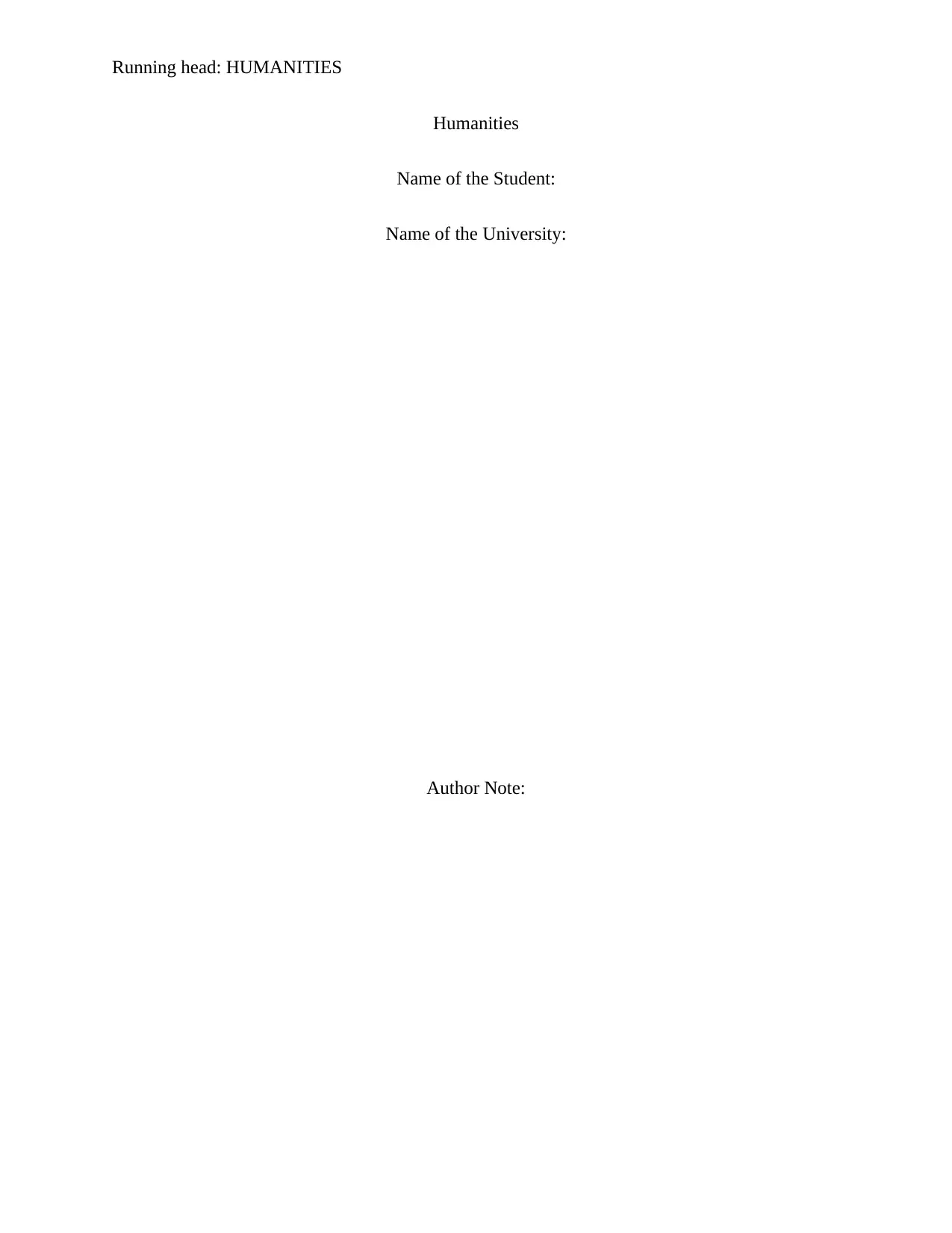
Running head: HUMANITIES
Humanities
Name of the Student:
Name of the University:
Author Note:
Humanities
Name of the Student:
Name of the University:
Author Note:
Paraphrase This Document
Need a fresh take? Get an instant paraphrase of this document with our AI Paraphraser
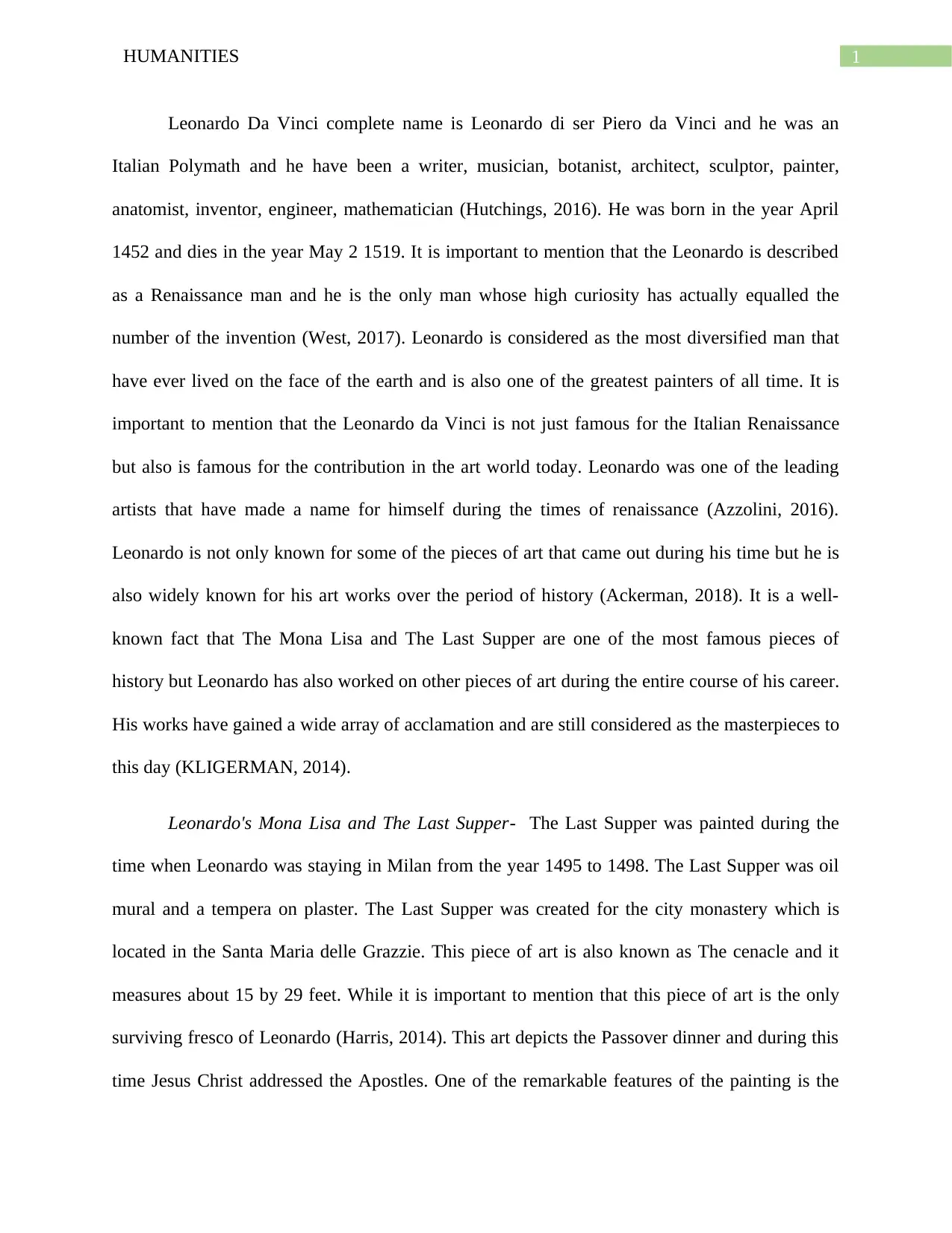
1HUMANITIES
Leonardo Da Vinci complete name is Leonardo di ser Piero da Vinci and he was an
Italian Polymath and he have been a writer, musician, botanist, architect, sculptor, painter,
anatomist, inventor, engineer, mathematician (Hutchings, 2016). He was born in the year April
1452 and dies in the year May 2 1519. It is important to mention that the Leonardo is described
as a Renaissance man and he is the only man whose high curiosity has actually equalled the
number of the invention (West, 2017). Leonardo is considered as the most diversified man that
have ever lived on the face of the earth and is also one of the greatest painters of all time. It is
important to mention that the Leonardo da Vinci is not just famous for the Italian Renaissance
but also is famous for the contribution in the art world today. Leonardo was one of the leading
artists that have made a name for himself during the times of renaissance (Azzolini, 2016).
Leonardo is not only known for some of the pieces of art that came out during his time but he is
also widely known for his art works over the period of history (Ackerman, 2018). It is a well-
known fact that The Mona Lisa and The Last Supper are one of the most famous pieces of
history but Leonardo has also worked on other pieces of art during the entire course of his career.
His works have gained a wide array of acclamation and are still considered as the masterpieces to
this day (KLIGERMAN, 2014).
Leonardo's Mona Lisa and The Last Supper- The Last Supper was painted during the
time when Leonardo was staying in Milan from the year 1495 to 1498. The Last Supper was oil
mural and a tempera on plaster. The Last Supper was created for the city monastery which is
located in the Santa Maria delle Grazzie. This piece of art is also known as The cenacle and it
measures about 15 by 29 feet. While it is important to mention that this piece of art is the only
surviving fresco of Leonardo (Harris, 2014). This art depicts the Passover dinner and during this
time Jesus Christ addressed the Apostles. One of the remarkable features of the painting is the
Leonardo Da Vinci complete name is Leonardo di ser Piero da Vinci and he was an
Italian Polymath and he have been a writer, musician, botanist, architect, sculptor, painter,
anatomist, inventor, engineer, mathematician (Hutchings, 2016). He was born in the year April
1452 and dies in the year May 2 1519. It is important to mention that the Leonardo is described
as a Renaissance man and he is the only man whose high curiosity has actually equalled the
number of the invention (West, 2017). Leonardo is considered as the most diversified man that
have ever lived on the face of the earth and is also one of the greatest painters of all time. It is
important to mention that the Leonardo da Vinci is not just famous for the Italian Renaissance
but also is famous for the contribution in the art world today. Leonardo was one of the leading
artists that have made a name for himself during the times of renaissance (Azzolini, 2016).
Leonardo is not only known for some of the pieces of art that came out during his time but he is
also widely known for his art works over the period of history (Ackerman, 2018). It is a well-
known fact that The Mona Lisa and The Last Supper are one of the most famous pieces of
history but Leonardo has also worked on other pieces of art during the entire course of his career.
His works have gained a wide array of acclamation and are still considered as the masterpieces to
this day (KLIGERMAN, 2014).
Leonardo's Mona Lisa and The Last Supper- The Last Supper was painted during the
time when Leonardo was staying in Milan from the year 1495 to 1498. The Last Supper was oil
mural and a tempera on plaster. The Last Supper was created for the city monastery which is
located in the Santa Maria delle Grazzie. This piece of art is also known as The cenacle and it
measures about 15 by 29 feet. While it is important to mention that this piece of art is the only
surviving fresco of Leonardo (Harris, 2014). This art depicts the Passover dinner and during this
time Jesus Christ addressed the Apostles. One of the remarkable features of the painting is the
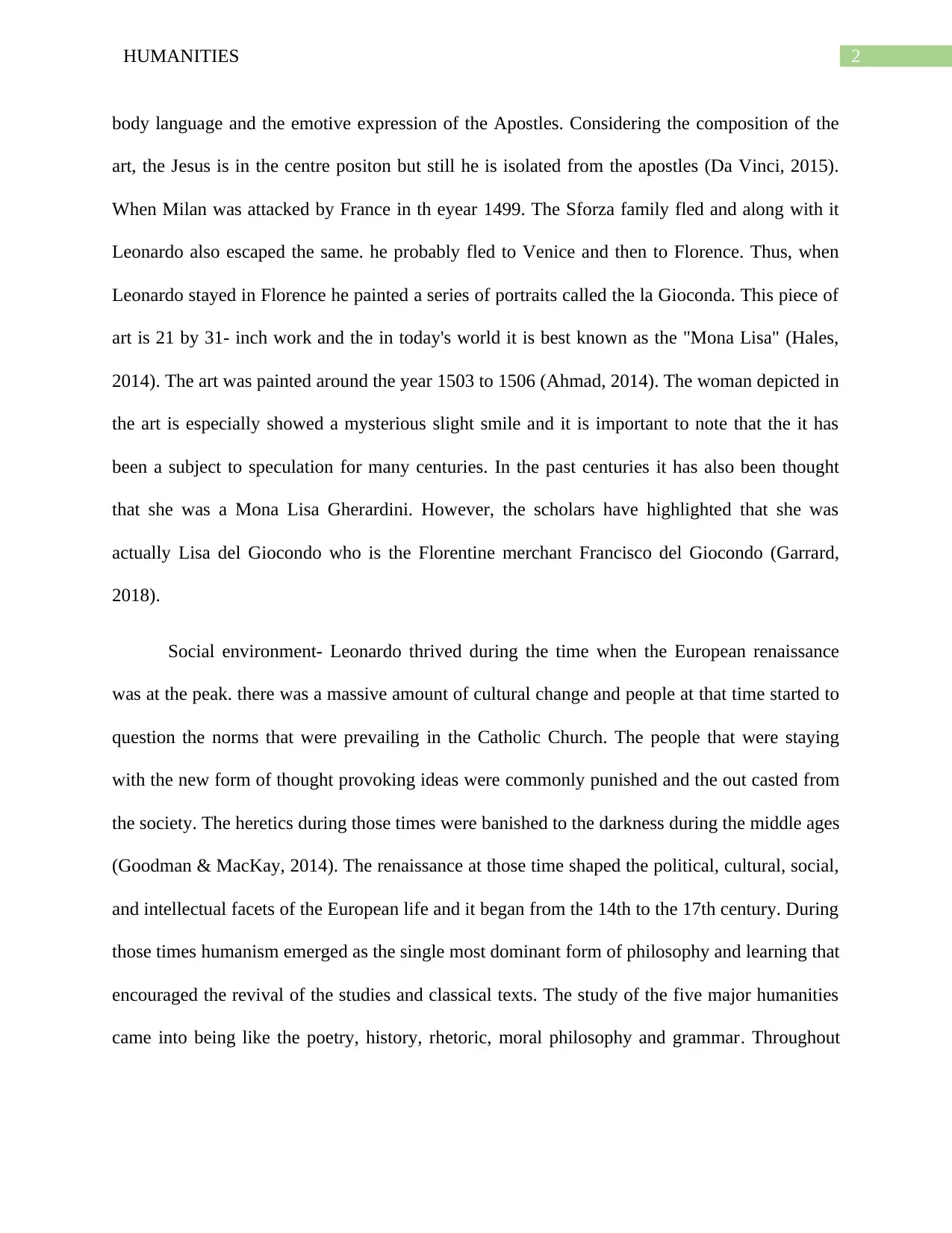
2HUMANITIES
body language and the emotive expression of the Apostles. Considering the composition of the
art, the Jesus is in the centre positon but still he is isolated from the apostles (Da Vinci, 2015).
When Milan was attacked by France in th eyear 1499. The Sforza family fled and along with it
Leonardo also escaped the same. he probably fled to Venice and then to Florence. Thus, when
Leonardo stayed in Florence he painted a series of portraits called the la Gioconda. This piece of
art is 21 by 31- inch work and the in today's world it is best known as the "Mona Lisa" (Hales,
2014). The art was painted around the year 1503 to 1506 (Ahmad, 2014). The woman depicted in
the art is especially showed a mysterious slight smile and it is important to note that the it has
been a subject to speculation for many centuries. In the past centuries it has also been thought
that she was a Mona Lisa Gherardini. However, the scholars have highlighted that she was
actually Lisa del Giocondo who is the Florentine merchant Francisco del Giocondo (Garrard,
2018).
Social environment- Leonardo thrived during the time when the European renaissance
was at the peak. there was a massive amount of cultural change and people at that time started to
question the norms that were prevailing in the Catholic Church. The people that were staying
with the new form of thought provoking ideas were commonly punished and the out casted from
the society. The heretics during those times were banished to the darkness during the middle ages
(Goodman & MacKay, 2014). The renaissance at those time shaped the political, cultural, social,
and intellectual facets of the European life and it began from the 14th to the 17th century. During
those times humanism emerged as the single most dominant form of philosophy and learning that
encouraged the revival of the studies and classical texts. The study of the five major humanities
came into being like the poetry, history, rhetoric, moral philosophy and grammar. Throughout
body language and the emotive expression of the Apostles. Considering the composition of the
art, the Jesus is in the centre positon but still he is isolated from the apostles (Da Vinci, 2015).
When Milan was attacked by France in th eyear 1499. The Sforza family fled and along with it
Leonardo also escaped the same. he probably fled to Venice and then to Florence. Thus, when
Leonardo stayed in Florence he painted a series of portraits called the la Gioconda. This piece of
art is 21 by 31- inch work and the in today's world it is best known as the "Mona Lisa" (Hales,
2014). The art was painted around the year 1503 to 1506 (Ahmad, 2014). The woman depicted in
the art is especially showed a mysterious slight smile and it is important to note that the it has
been a subject to speculation for many centuries. In the past centuries it has also been thought
that she was a Mona Lisa Gherardini. However, the scholars have highlighted that she was
actually Lisa del Giocondo who is the Florentine merchant Francisco del Giocondo (Garrard,
2018).
Social environment- Leonardo thrived during the time when the European renaissance
was at the peak. there was a massive amount of cultural change and people at that time started to
question the norms that were prevailing in the Catholic Church. The people that were staying
with the new form of thought provoking ideas were commonly punished and the out casted from
the society. The heretics during those times were banished to the darkness during the middle ages
(Goodman & MacKay, 2014). The renaissance at those time shaped the political, cultural, social,
and intellectual facets of the European life and it began from the 14th to the 17th century. During
those times humanism emerged as the single most dominant form of philosophy and learning that
encouraged the revival of the studies and classical texts. The study of the five major humanities
came into being like the poetry, history, rhetoric, moral philosophy and grammar. Throughout
⊘ This is a preview!⊘
Do you want full access?
Subscribe today to unlock all pages.

Trusted by 1+ million students worldwide
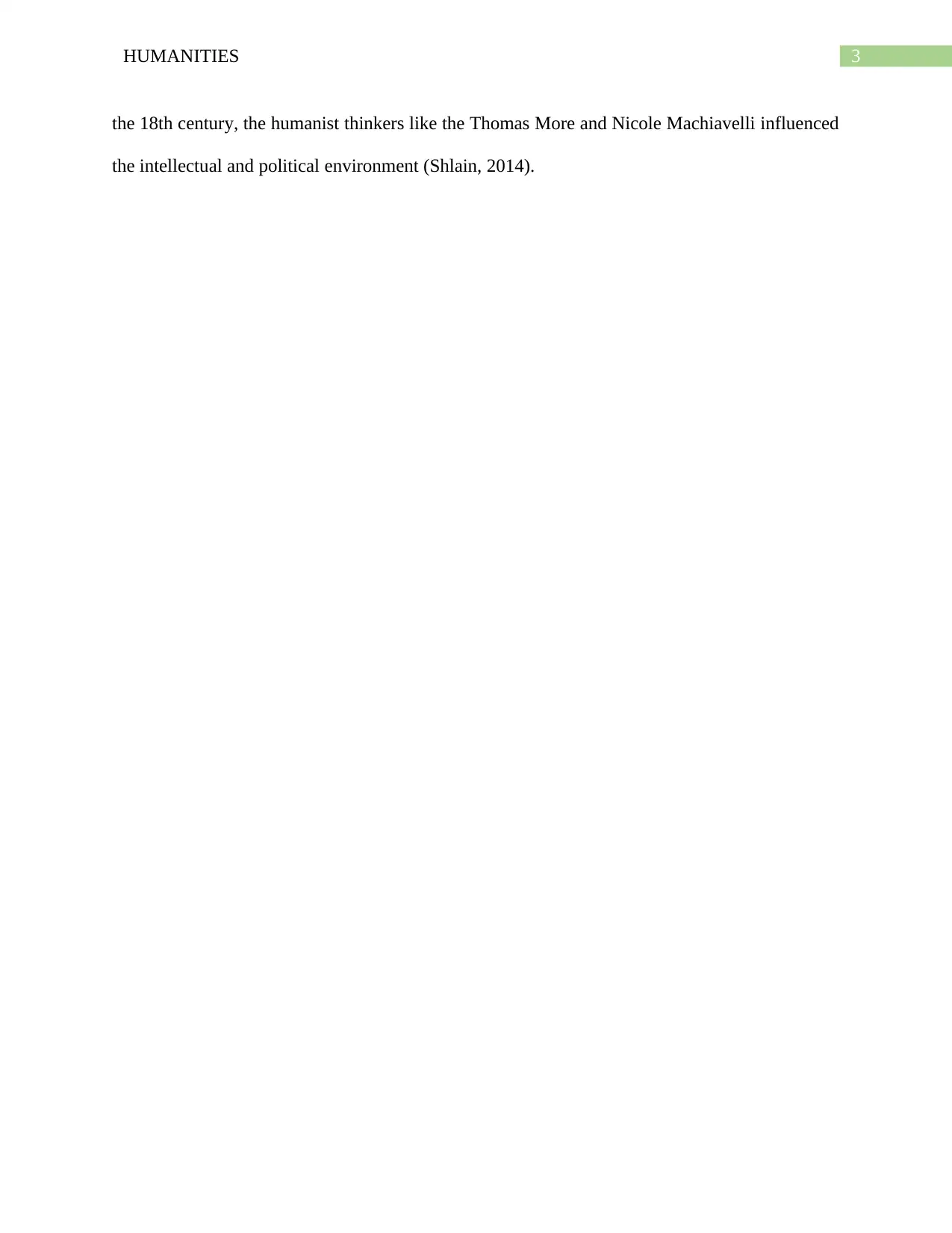
3HUMANITIES
the 18th century, the humanist thinkers like the Thomas More and Nicole Machiavelli influenced
the intellectual and political environment (Shlain, 2014).
the 18th century, the humanist thinkers like the Thomas More and Nicole Machiavelli influenced
the intellectual and political environment (Shlain, 2014).
Paraphrase This Document
Need a fresh take? Get an instant paraphrase of this document with our AI Paraphraser
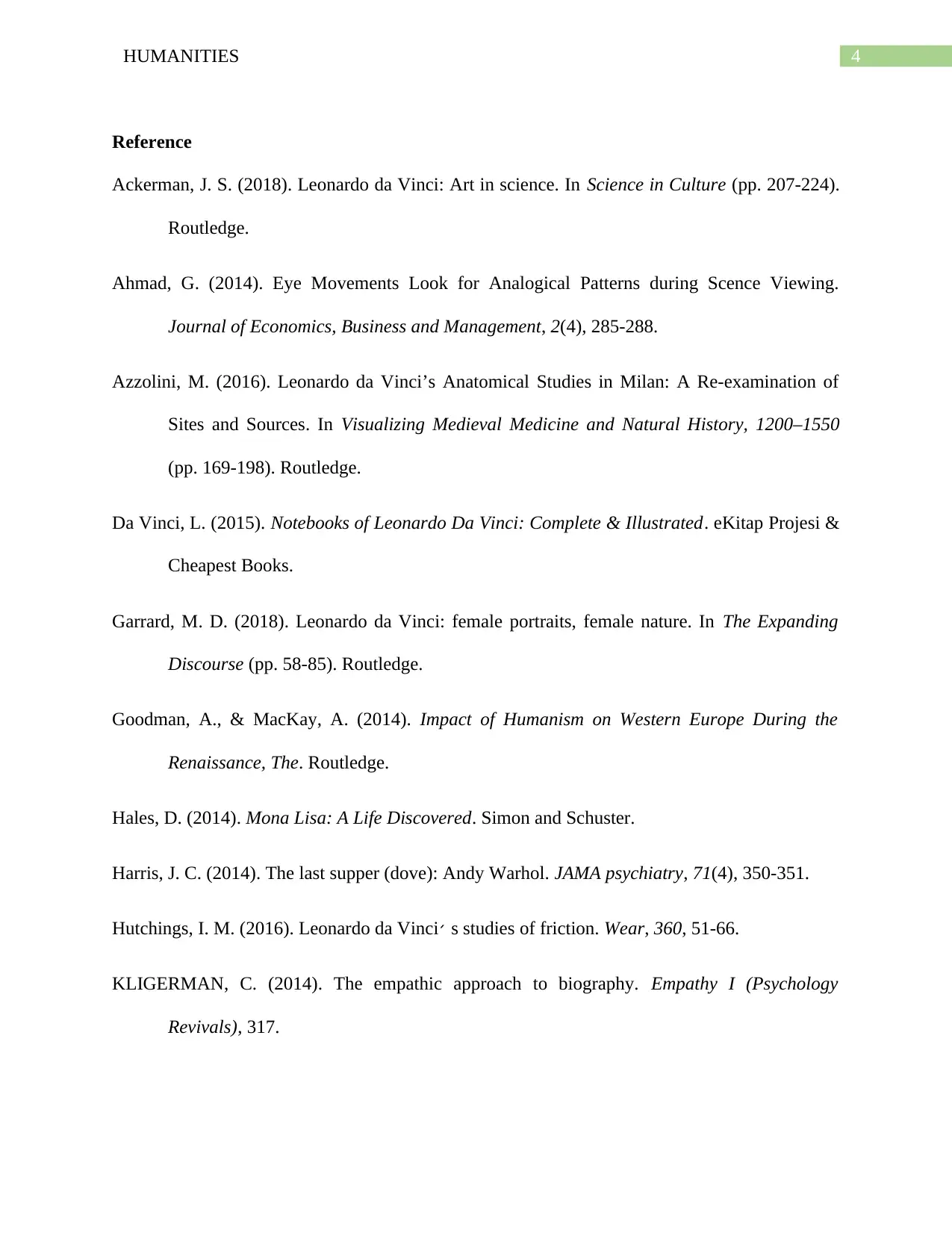
4HUMANITIES
Reference
Ackerman, J. S. (2018). Leonardo da Vinci: Art in science. In Science in Culture (pp. 207-224).
Routledge.
Ahmad, G. (2014). Eye Movements Look for Analogical Patterns during Scence Viewing.
Journal of Economics, Business and Management, 2(4), 285-288.
Azzolini, M. (2016). Leonardo da Vinci’s Anatomical Studies in Milan: A Re-examination of
Sites and Sources. In Visualizing Medieval Medicine and Natural History, 1200–1550
(pp. 169-198). Routledge.
Da Vinci, L. (2015). Notebooks of Leonardo Da Vinci: Complete & Illustrated. eKitap Projesi &
Cheapest Books.
Garrard, M. D. (2018). Leonardo da Vinci: female portraits, female nature. In The Expanding
Discourse (pp. 58-85). Routledge.
Goodman, A., & MacKay, A. (2014). Impact of Humanism on Western Europe During the
Renaissance, The. Routledge.
Hales, D. (2014). Mona Lisa: A Life Discovered. Simon and Schuster.
Harris, J. C. (2014). The last supper (dove): Andy Warhol. JAMA psychiatry, 71(4), 350-351.
Hutchings, I. M. (2016). Leonardo da Vinci׳ s studies of friction. Wear, 360, 51-66.
KLIGERMAN, C. (2014). The empathic approach to biography. Empathy I (Psychology
Revivals), 317.
Reference
Ackerman, J. S. (2018). Leonardo da Vinci: Art in science. In Science in Culture (pp. 207-224).
Routledge.
Ahmad, G. (2014). Eye Movements Look for Analogical Patterns during Scence Viewing.
Journal of Economics, Business and Management, 2(4), 285-288.
Azzolini, M. (2016). Leonardo da Vinci’s Anatomical Studies in Milan: A Re-examination of
Sites and Sources. In Visualizing Medieval Medicine and Natural History, 1200–1550
(pp. 169-198). Routledge.
Da Vinci, L. (2015). Notebooks of Leonardo Da Vinci: Complete & Illustrated. eKitap Projesi &
Cheapest Books.
Garrard, M. D. (2018). Leonardo da Vinci: female portraits, female nature. In The Expanding
Discourse (pp. 58-85). Routledge.
Goodman, A., & MacKay, A. (2014). Impact of Humanism on Western Europe During the
Renaissance, The. Routledge.
Hales, D. (2014). Mona Lisa: A Life Discovered. Simon and Schuster.
Harris, J. C. (2014). The last supper (dove): Andy Warhol. JAMA psychiatry, 71(4), 350-351.
Hutchings, I. M. (2016). Leonardo da Vinci׳ s studies of friction. Wear, 360, 51-66.
KLIGERMAN, C. (2014). The empathic approach to biography. Empathy I (Psychology
Revivals), 317.
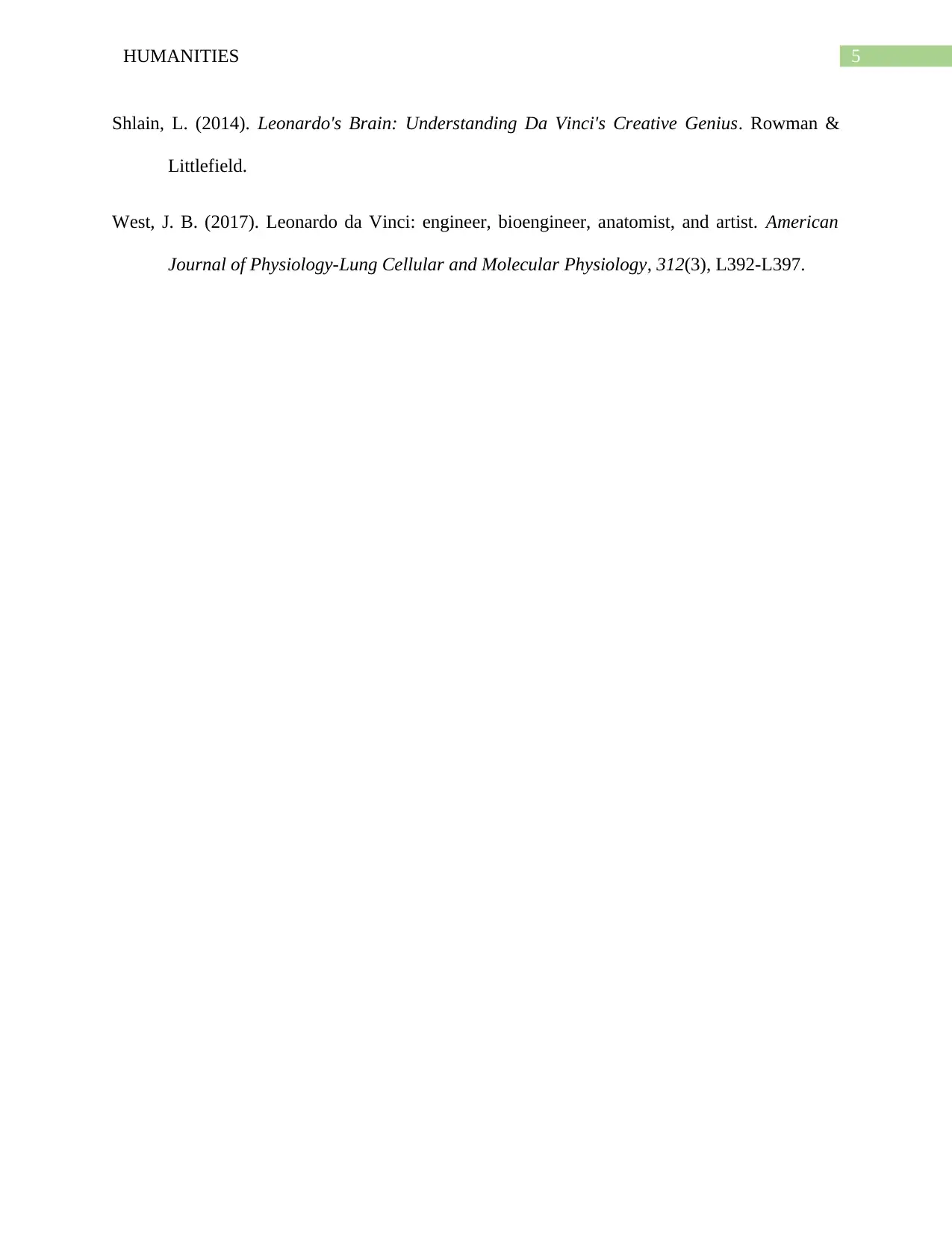
5HUMANITIES
Shlain, L. (2014). Leonardo's Brain: Understanding Da Vinci's Creative Genius. Rowman &
Littlefield.
West, J. B. (2017). Leonardo da Vinci: engineer, bioengineer, anatomist, and artist. American
Journal of Physiology-Lung Cellular and Molecular Physiology, 312(3), L392-L397.
Shlain, L. (2014). Leonardo's Brain: Understanding Da Vinci's Creative Genius. Rowman &
Littlefield.
West, J. B. (2017). Leonardo da Vinci: engineer, bioengineer, anatomist, and artist. American
Journal of Physiology-Lung Cellular and Molecular Physiology, 312(3), L392-L397.
⊘ This is a preview!⊘
Do you want full access?
Subscribe today to unlock all pages.

Trusted by 1+ million students worldwide
1 out of 6
Related Documents
Your All-in-One AI-Powered Toolkit for Academic Success.
+13062052269
info@desklib.com
Available 24*7 on WhatsApp / Email
![[object Object]](/_next/static/media/star-bottom.7253800d.svg)
Unlock your academic potential
Copyright © 2020–2025 A2Z Services. All Rights Reserved. Developed and managed by ZUCOL.




